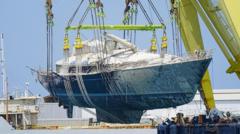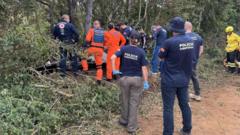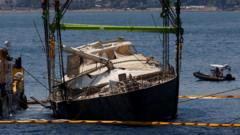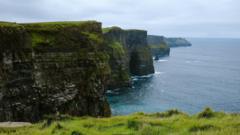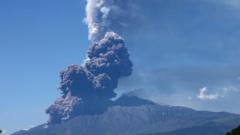A recent investigation into the sinking of the Bayesian superyacht off the coast of Sicily has uncovered key details about the events that contributed to the disaster.
Bayesian Superyacht Disaster Linked to Extreme Weather Conditions

Bayesian Superyacht Disaster Linked to Extreme Weather Conditions
Official investigation reveals critical factors leading to the tragic capsizing of the Bayesian, resulting in seven fatalities.
The harrowing calamity of the Bayesian superyacht, which sank last year near Sicily with a tragic loss of seven lives, has been attributed to a sudden and extreme wind gust, according to findings from a preliminary investigation by British maritime authorities. As the storm approached, a young deckhand made the alarming decision to film the squall instead of alerting the captain, which delayed critical rescue measures.
The report indicates that the yacht was overwhelmed within minutes, leading to chaos as crew and passengers fought for survival amidst rising waters. “The extreme wind experienced by Bayesian was sufficient to knock the yacht over,” stated Capt. Andrew Moll, the chief inspector of marine accidents for the Marine Accident Investigation Branch. The conditions of the storm caused the protective awning on the bridge to tear away, tipping the yacht dangerously onto its side.
One significant concern highlighted in the investigation was the design of the yacht itself. The Bayesian sported a single, towering mast—one of the tallest globally—which notably increased its susceptibility to capsizing during high winds. This design flaw drew comparisons to other vessels from the same manufacturer, which typically feature a double-mast design that enhances stability. While the makers of Bayesian had previously touted the vessel as “unsinkable” when operated correctly, the examination by independent experts raised questions about its overall stability and ballast configuration.
The report serves as a grim reminder of the interplay between human actions and environmental factors in maritime safety, highlighting the necessity for greater vigilance and adherence to safety protocols in hazardous conditions.
The report indicates that the yacht was overwhelmed within minutes, leading to chaos as crew and passengers fought for survival amidst rising waters. “The extreme wind experienced by Bayesian was sufficient to knock the yacht over,” stated Capt. Andrew Moll, the chief inspector of marine accidents for the Marine Accident Investigation Branch. The conditions of the storm caused the protective awning on the bridge to tear away, tipping the yacht dangerously onto its side.
One significant concern highlighted in the investigation was the design of the yacht itself. The Bayesian sported a single, towering mast—one of the tallest globally—which notably increased its susceptibility to capsizing during high winds. This design flaw drew comparisons to other vessels from the same manufacturer, which typically feature a double-mast design that enhances stability. While the makers of Bayesian had previously touted the vessel as “unsinkable” when operated correctly, the examination by independent experts raised questions about its overall stability and ballast configuration.
The report serves as a grim reminder of the interplay between human actions and environmental factors in maritime safety, highlighting the necessity for greater vigilance and adherence to safety protocols in hazardous conditions.


